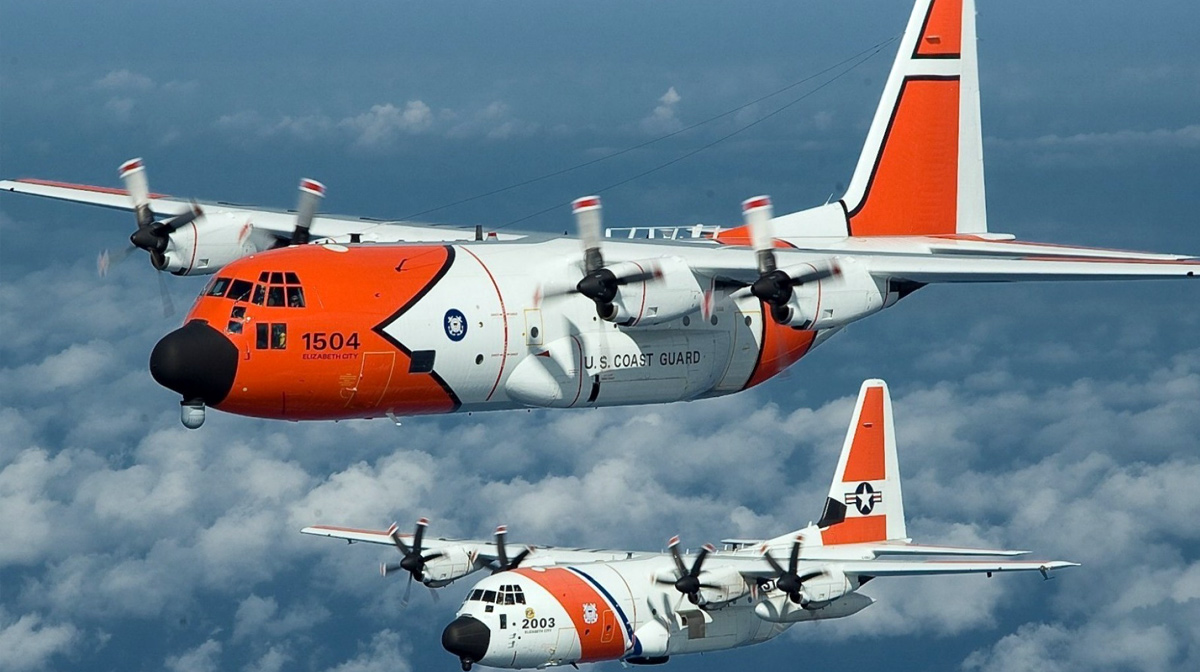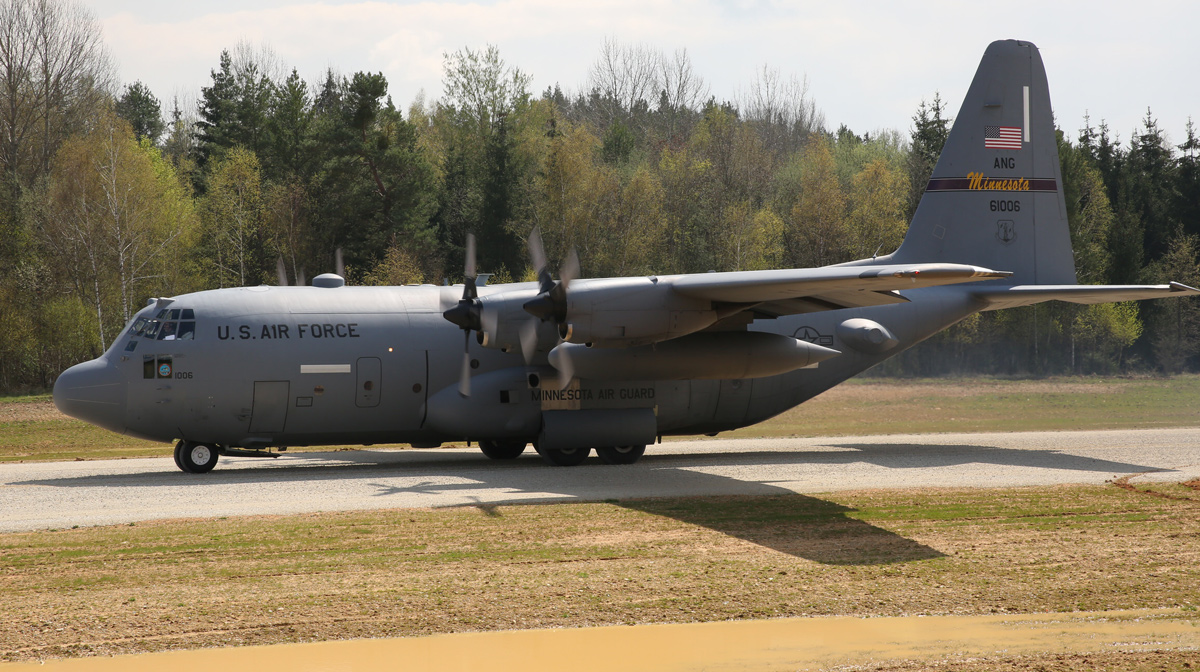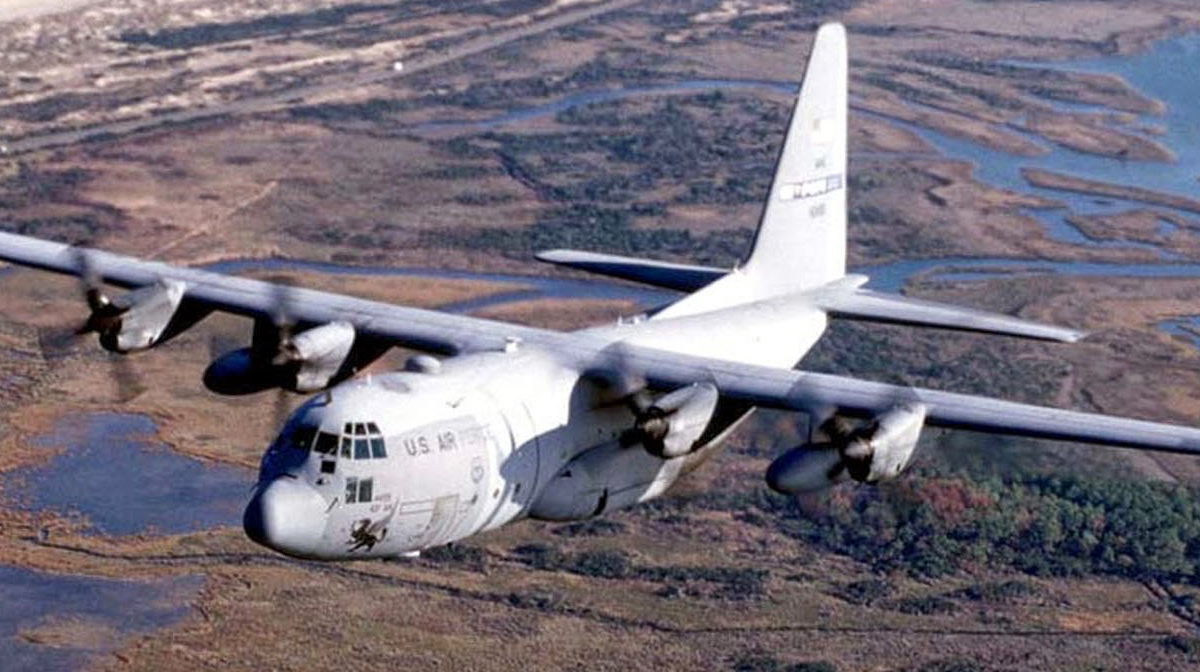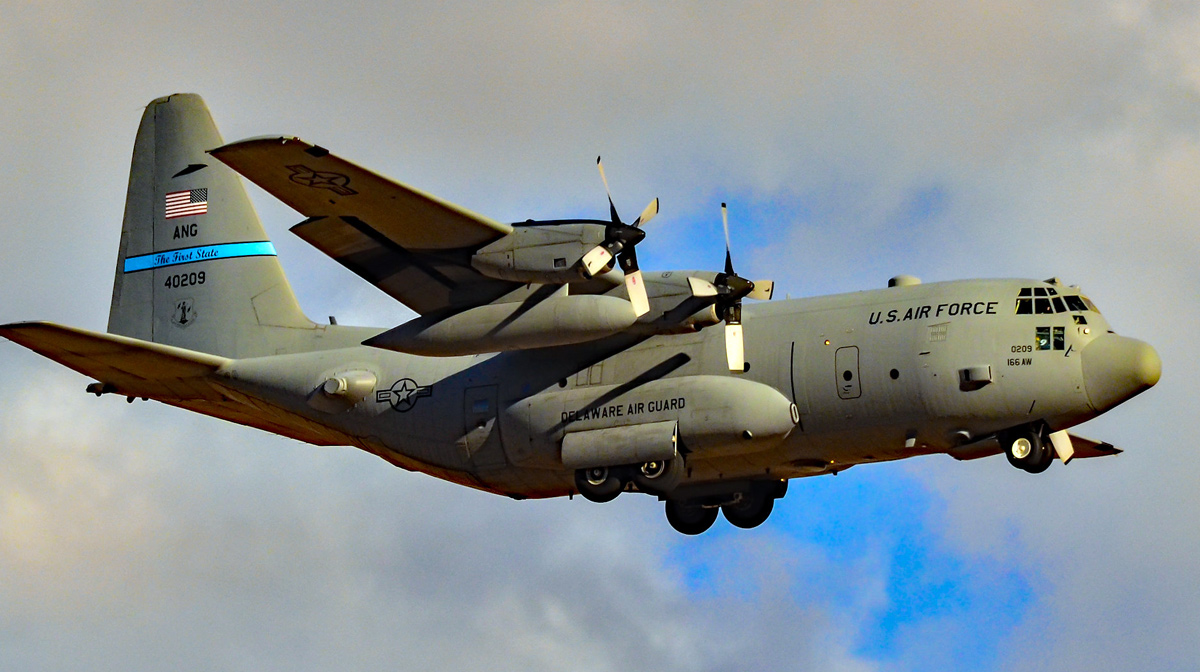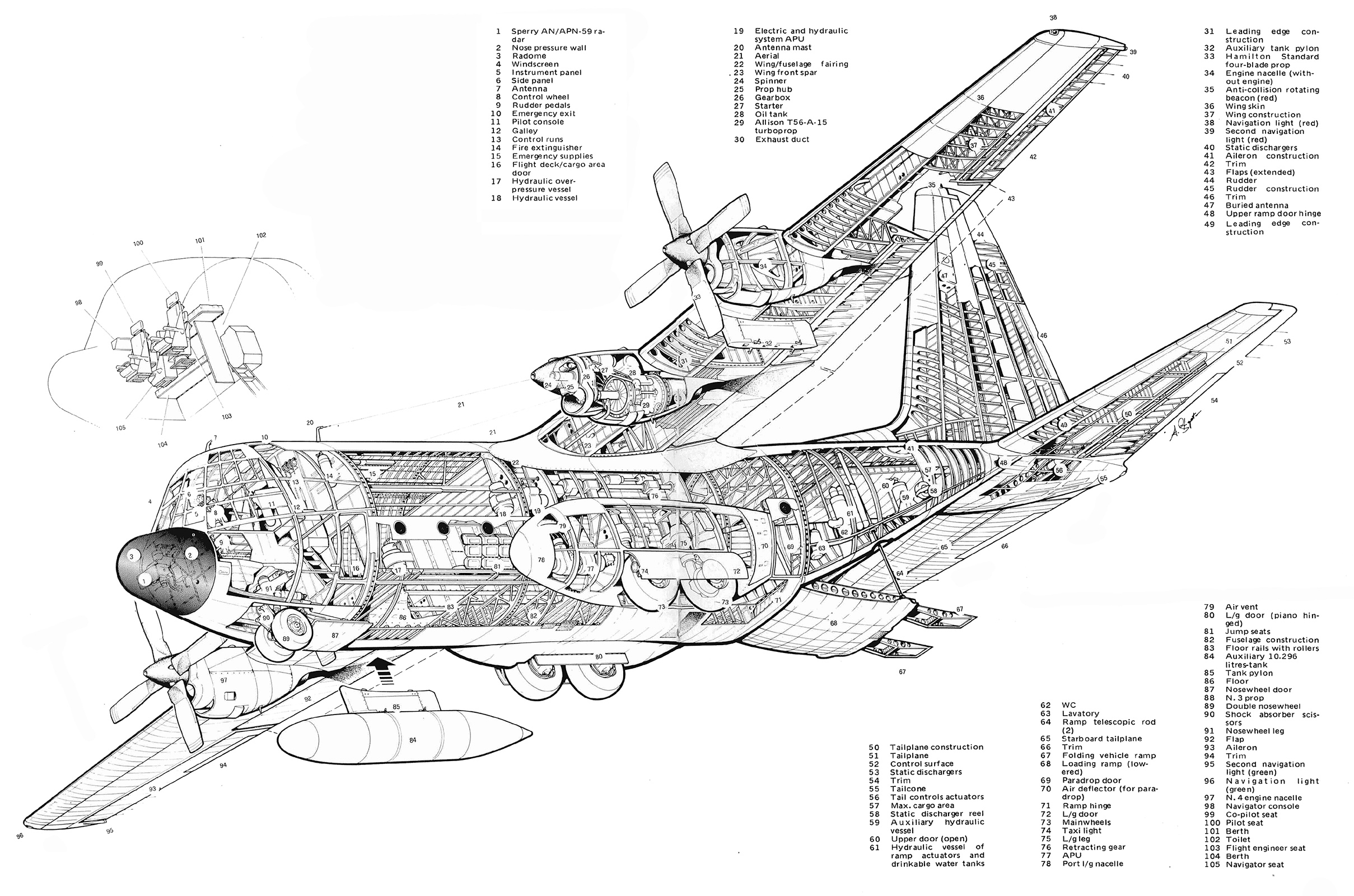Price: $16.95
- 2 magazines, 6 manuals, & photos
- PDF contains 4,596 pages
- Content is keyword searchable
- Print a personal copy
- Pay via PayPal or Credit Card
- International orders welcome!
- Download files upon payment
April 1980
- Watch on the Rhine, Hitler’s “Fortress Europa”
- Return of the Swallow (Messerschmitt Me-262 Jet)
- Night Spectre (Lockheed C-130 Gunship)
- Fairey Aviation’s Forgotten Long-Distance Monoplane
August 1993
- The Flying Gun, North American’s B-25 Mitchell
- A Box With Wings, Lockheed’s C-130 Hercules
Manuals & Photos
- AC-130A Flight Manual
- AC-130A Performance Data
- C-130B Flight Manual
- NATOPS C-130T Flight Manual
- NATOPS EC-130G/C Flight Manual
- NATOPS KC-130J Flight Manual
- Over 700 C-130 photos
Lockheed C-130 Hercules
C-130H Specifications
Variants
On Display
Cutaway
Videos
General Characteristics

- Crew: five (two pilots, navigator, flight engineer and loadmaster)
- Capacity:
- C-130E/H/J cargo hold: length, 40 feet (12.19 m); width, 119 inches (3.02 m); height, 9 feet (2.74 m). Rear ramp: length, 123 inches (3.12 m); width, 119 inches (3.02 m)
- C-130J-30 cargo hold: length, 55 feet (16.76 m); width, 119 inches (3.02 m); height, 9 feet (2.74 m). Rear ramp: length, 123 inches (3.12 m); width, 119 inches (3.02 m)
- 92 passengers or
- 64 airborne troops or
- 74 litter patients with 5 medical crew or
- 6 pallets or
- 2–3 Humvees or
- 2 M113 armored personnel carriers
- 1 CAESAR self-propelled howitzer
- Payload: 45,000 lb (20,400 kg)
- Length: 97 ft 9 in (29.8 m)
- Wingspan: 132 ft 7 in (40.4 m)
- Height: 38 ft 3 in (11.6 m)
- Wing area: 1,745 ft2 (162.1 m2)
- Empty weight: 75,800 lb (34,400 kg)
- Useful load: 72,000 lb (33,000 kg)
- Max. takeoff weight: 155,000 lb (70,300 kg)
- Powerplant: 4 × Allison T56-A-15 turboprops, 4,590 shp (3,430 kW) each
- Propellers: 4 propellers
- Propeller diameter: 13.5 ft (4.1 m)
Performance
- Maximum speed: 320 knots (366 mph, 592 km/h) at 20,000 ft (6,060 m)
- Cruise speed: 292 kts (336 mph, 540 km/h)
- Range: 2,050 nmi (2,360 mi, 3,800 km)
- Service ceiling: 33,000 ft (10,060 m) empty; 23,000 ft (7,077 m) with 42,000 pounds (19,090 kilograms) payload
- Rate of climb: 1,830 ft/min (9.3 m/s)
- Takeoff distance: 3,586 ft (1,093 m) at 155,000 lb (70,300 kg) max gross weight; 1,400 ft (427 m) at 80,000 lb (36,300 kg) gross weight
Avionics
- Westinghouse Electronic Systems (now Northrop Grumman) AN/APN-241 weather and navigational radar
- C-130A/B/E/F/G/H/K/T — Tactical airlifter basic models.
- C-130A-II Dreamboat — Early version Electronic Intelligence/Signals Intelligence (ELINT/SIGINT) aircraft.
- C-130J Super Hercules — Tactical airlifter, with new engines, avionics, and updated systems.
- C-130K — Designation for RAF Hercules C1/W2/C3 aircraft (C-130Js in RAF service are the Hercules C.4 and Hercules C.5).
- AC-130A/E/H/J/U/W — Gunship variants.
- C-130D/D-6 — Ski-equipped version for snow and ice operations United States Air Force / Air National Guard
- CC-130E/H/J Hercules — Designation for Canadian Armed Forces / Royal Canadian Air Force Hercules aircraft. U.S. Air Force used the CC-130J designation to differentiate the standard C-130J variant from the “stretched” C-130J (company designation C-130J-30).
- C-130M — Designation used by the Brazilian Air Force for locally modified / up-graded C-130H aircraft.
- DC-130A/E/H — USAF and USN Drone control.
- EC-130 — EC-130E/J Commando Solo – USAF / Air National Guard psychological operations version.
- EC-130E Airborne Battlefield Command and Control Center (ABCCC) – USAF procedural air-to-ground attack control, also provided NRT threat updates.
- EC-130E Rivet Rider – Airborne psychological warfare aircraft.
- EC-130H Compass Call – Electronic warfare and electronic attack.
- EC-130V – Airborne early warning and control (AEW&C) variant used by USCG for counter-narcotics missions
- GC-130 — Permanently grounded instructional airframes.
- HC-130 — HC-130B/E/H – Early model combat search and rescue.
- HC-130P/N Combat King – USAF aerial refueling tanker and combat search and rescue.
- HC-130J Combat King II – Next generation combat search and rescue tanker.
- HC-130H/J – USCG long-range surveillance and search and rescue.
- JC-130 — Temporary conversion for flight test operations; Also used to recover film from American spy satellites.
- KC-130F/R/T/J — United States Marine Corps aerial refueling tanker and tactical airlifter.
- LC-130F/H/R — USAF / Air National Guard – Ski-equipped version for Arctic and Antarctic support operations; LC-130F and R previously operated by USN.
- MC-130 — MC-130E/H Combat Talon I/II – Special operations infiltration/extraction variant.
- MC-130W Combat Spear/Dragon Spear – Special operations tanker/gunship.
- MC-130P Combat Shadow – Special operations tanker.
- MC-130J Commando II (formerly Combat Shadow II) – Special operations tanker Air Force Special Operations Command.
- YMC-130H – Modified aircraft under Operation Credible Sport for second Iran hostage crisis rescue attempt
- NC-130 — Permanent conversion for flight test operations.
- PC-130/C-130-MP — Maritime patrol.
- RC-130A/S — Surveillance aircraft for reconnaissance.
- SC-130J Sea Herc — Proposed maritime patrol version of the C-130J, designed for coastal surveillance and anti-submarine warfare.
- TC-130 — Aircrew training.
- VC-130H — VIP transport.
- WC-130A/B/E/H/J — Weather reconnaissance (“Hurricane Hunter”) version for USAF / Air Force Reserve Command’s 53d Weather Reconnaissance Squadron in support of the National Weather Service’s National Hurricane Center.
Argentina
- C-130B FAA TC-60. ex USAF 61-0964 received on February 1992 now at Museo Nacional de Aeronáutica since September 2011.
Australia
- C-130A RAAF A97-214 used by 36 Squadron from early 1959, withdrawn from use late 1978; now at RAAF Museum, RAAF Base Williams, Point Cook.
- C-130E RAAF A97-160 used by 37 Squadron from August 1966, withdrawn from use November 2000; to RAAF Museum, 14 November 2000, cocooned as of September 2005.
Canada
- CC-130E RCAF 10313 (later 130313) is on display at the National Air Force Museum of Canada, CFB Trenton
- CC-130E RCAF 130328 is on display at the Greenwood Aviation Museum, CFB Greenwood
Colombia
- C-130B FAC 1010 (serial number 3521) moved on 14 January 2016 to the Colombian Aerospace Museum in Tocancipá, Cundinamarca, for static display.
- C-130B FAC1011 (serial number 3585, ex 59-1535) preserved at the Colombian Air and Space Museum within CATAM AFB, Bogotá.
Indonesia
- C-130B Indonesian Air Force A-1301 preserved at Sulaeman Airstrip, Bandung. Also occasionally used for Paskhas Training.The airplane is relocated to Air Force Museum in Yogyakarta in 2017.
Norway
- C-130H Royal Norwegian Air Force 953 was retired 10 June 2007 and moved to the Air Force museum at Oslo Gardermoen in May 2008.
Saudi Arabia
- C-130H RSAF 460 was operated by 4 Squadron Royal Saudi Air Force, December 1974 until January 1987. It was damaged in a fire at Jeddah in December 1989. Restored for ground training by August 1993. At Royal Saudi Air Force Museum, November 2002, restored for ground display by using a tail from another C-130H.
United Kingdom
- Hercules C3 XV202 served with the Royal Air Force from 1967 to 2011, is on display at the Royal Air Force Museum Cosford.
United States
- GC-130A, AF Ser. No. 55-037 used by the 773 TCS, 483 TCW, 315 AD, 374 TCW, 815 TAS, 35 TAS, 109 TAS, belly-landed at Duluth, Minnesota, April 1973, repaired; 167 TAS, 180 TAS, to Chanute Technical Training Center as GC-130A, May 1984; now displayed at Museum of Missouri Military History, Missouri National Guard Ike Skelton Training Center, Jefferson City, Missouri. Previously displayed at Octave Chanute Aerospace Museum, (former Chanute AFB, Rantoul, Illinois until museum closed.
- C-130A, AF Ser. No. 56-0518 used by the 314 TCW, 315 AD, 41 ATS, 328 TAS; to Republic of Vietnam Air Force 435 Transport Squadron, November 1972; holds the C-130 record for taking off with the most personnel on board, during evacuation of SVN, 29 April 1975, with 452. Returned to USAF, 185 TAS, 105 TAS; Flown to Little Rock AFB on June 28, 1989. It was converted to a static display at the LRAFB Visitor Center, Arkansas by Sept. 1989
- C-130A, AF Ser. No. 57-0453 was operated from 1958 to 1991, last duty with 155th TAS, 164th TAG, Tennessee Air National Guard, Memphis International Airport/ANGB, Tennessee, 1976–1991, named “Nite Train to Memphis”; to AMARC in December 1991, then sent to Texas for modification into replica of C-130A-II Dreamboat aircraft, AF Ser. No. 56-0528, shot down by Soviet fighters in Soviet airspace near Yerevan, Armenia on 2 September 1958, while on ELINTmission with loss of all crew, displayed in National Vigilance Park, National Security Agency grounds, Fort George Meade, Maryland.
- C-130B, AF Ser. No. 59-0528 was operated by 145th Airlift Wing, North Carolina Air National Guard; placed on static display at Charlotte Air National Guard Base, North Carolina in 2010.
- C-130D, AF Ser. No. 57-0490 used by the 61st TCS, 17th TCS, 139th TAS with skis, July 1975 – April 1983; to MASDC, 1984–1985, GC-130D ground trainer, Chanute AFB, Illinois, 1986–1990; When Chanute AFB closed in September 1993, it moved to the Octave Chanute Aerospace Museum (former Chanute AFB, Rantoul, Illinois. In July 1994, it moved to the Empire State Air Museum, Schenectady County Airport, New York, until placed on the gate at Stratton Air National Guard Base in October 1994.
- NC-130B, AF Ser. No. 57-0526 was the second B model manufactured, initially delivered as JC-130B; assigned to 6515th Organizational Maintenance Squadron for flight testing at Edwards AFB, California on 29 November 1960; turned over to 6593rd Test Squadron’s Operating Location No. 1 at Edwards AFB and spent next seven years supporting Corona Program; “J” status and prefix removed from aircraft on October 1967; transferred to 6593rd Test Squadron at Hickam AFB, Hawaii and modified for mid-air retrieval of satellites; acquired by 6514th Test Squadron at Hill AFB, Utah in Jan. 1987 and used as electronic testbed and cargo transport; aircraft retired January 1994 with 11,000+ flight hours and moved to Hill Aerospace Museum at Hill AFB by January 1994.
- C-130E, AF Ser. No. 62-1787, on display at the National Museum of the United States Air Force, Wright-Patterson AFB, Ohio, was flown to the museum on 18 August 2011. One of the greatest feats of heroism during the Vietnam War involved the C-130E, call sign “Spare 617”. The C-130E attempted to airdrop ammunition to surrounded South Vietnamese forces at An Loc, Vietnam. Approaching the drop zone, Spare 617 received heavy enemy ground fire that damaged two engines, ruptured a bleed air duct in the cargo compartment, and set the ammunition on fire. Flight engineer TSgt Sanders was killed, and navigator 1st Lt Lenz and co-pilot 1st Lt Hering were both wounded. Despite receiving severe burns from hot air escaping from the damaged air bleed duct, loadmaster TSgt Shaub extinguished a fire in the cargo compartment, and successfully jettisoned the cargo pallets, which exploded in mid-air. Despite losing a third engine on final approach, pilot Capt Caldwell landed Spare 617 safely. For their actions, Caldwell and Shaub received the Air Force Cross, the U.S. Air Force’s second highest award for valor. TSgt Shaub also received the William H. Pitsenbarger Award for Heroism from the Air Force Sergeants Association.
- KC-130F, USN/USMC BuNo 149798 used in tests in October–November 1963 by the U.S. Navy for unarrested landings and unassisted take-offs from the carrier USS Forrestal (CV-59), it remains the record holder for largest aircraft to operate from a carrier flight deck, and carried the name “Look Ma, No Hook” during the tests. Retired to the National Museum of Naval Aviation, NAS Pensacola, Florida in May 2003.
- C-130G, USN/USMC BuNo 151891; modified to EC-130G, 1966, then testbed for EC-130Q TACAMO in 1981. To TC-130G in May 1990 and assigned as the U.S. Navy’s Blue Angels USMC support aircraft, serving as “Fat Albert Airlines” from 1991 to 2002. Retired to the National Museum of Naval Aviation at NAS Pensacola, Florida in November 2002.
- C-130E, AF Ser. No. 64-0525 was on display at the 82nd Airborne Division War Memorial Museum at Fort Bragg, North Carolina. The aircraft was the last assigned to the 43rd AW at Pope AFB, North Carolina prior to retirement from the USAF.
- C-130E, AF Ser. No. 69-6579 operated by the 61st TAS, 314th TAW, 50th AS, 61st AS; at Dyess AFB as maintenance trainer as GC-130E, March 1998; to Dyess AFB Linear Air Park, January 2004.
- MC-130E Combat Talon I, AF Ser. No. 64-0567, unofficially known as “Wild Thing”. It transported captured Panamanian dictator Manuel Noriega in 1989 during Operation Just Cause, and participated in Operation Eagle Claw, the unsuccessful attempt to rescue U.S. hostages from Iran in 1980. Wild Thing was also the first fixed-wing aircraft to employ night-vision goggles. On display at Hurlburt Field, in Florida.
- C-130E, AF Ser. No. 69-6580 operated by the 61st TAS, 314th TAW, 317th TAW, 314th TAW, 317th TAW, 40th AS, 41st AS, 43rd AW, retired after center wing cracks were detected in April 2002; to the Air Mobility Command Museum, Dover AFB, Delaware on 2 February 2004.
- C-130E, AF Ser. No. 70-1269 used by the 43rd AW and is on display at the Pope Air Park, Pope AFB, North Carolina as 2006.
- C-130H, AF Ser. No. 74-1686 used by the 463rd TAW; one of three C-130H airframes modified to YMC-130H for aborted rescue attempt of Iranian hostages, Operation Credible Sport, with rocket packages blistered onto fuselage in 1980, but these were removed after mission was canceled. Subsequent duty with the 4950th Test Wing, then donated to the Museum of Aviation at Robins AFB, Georgia, in March 1988.



